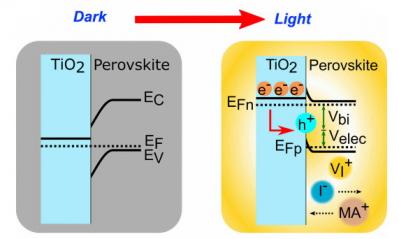A team of researchers from the Israeli Bar-Ilan University and the Spanish Universitat Jaume I in Castello and Universidad de Granada have showed that the contact interface of the perovskite material in a perovskite-based solar cell is behind the drastic and random fluctuations that happen when the solar panels are tested.

The researchers have discovered a light-induced interfacial phenomena in hybrid perovskite solar cells between the n-type contact (TiO2 or TiO2/PCBM interlayer) and the perovskite absorber. By changing the n-type contact and measuring the solar cells under the same conditions, it was demonstrated that the light-induced phenomena originates at the interface.
The migration of ions and vacancies at working conditions results in localized charge redistribution manifested as charge accumulating at the contact/perovskite interface.
This is a dramatic change in the consideration and treatment of solar cells, meaning that the contact/perovskite interface is not rigid, and it slowly builds up during illumination and recovers even more slowly.
One major conclusion in the new research is that characterization methods commonly used for solar panels needs to be done under-light conditions in the case of perovskite panels - otherwise the results will not be precise.

